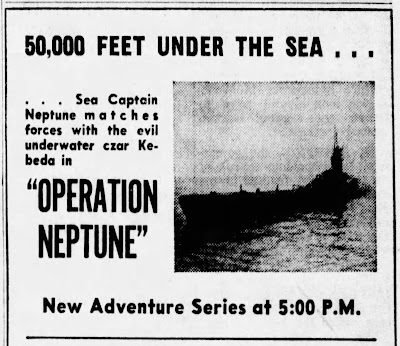Operation Neptune
(also known as "Captain Neptune" and "Operation: Neptune".
June 28, 1953 - August 16, 1953. NBC TV
Sundays 7:00PM EST
Creator/writer: Maurice Brockhauser
 |
| Advertisement for "Operation Neptune", the NBC undersea adventure series, from the Star Gazette (Minneapolis, Minnesota), July 28, 1953. |
Captain Video, Flash Gordon, Tom Corbett Space Cadet, nearly all the fantasy heroes of the Golden Age of Television took young viewers into the realms of outer space. In the summer of 1953 one program dared to be just as fantastic, but on Earth in the depths of the ocean, more in the territory of Jules Verne's 20,000 Leagues Under the Sea, or the 1936 movie serial Undersea Kingdom.
The series which was broadcast live from New York, was easily compared to Captain Video. It was a serialized television adventure of a captain and his young partner, against evils of another world, with a lackluster budget broadcast live from New York. An even stronger connection to Captain Video, was that "Operation Neptune" was created by Maurice Brockhauser, who had been the lead writer of "Captain Video" during its first two years, from 1949 - 1951 under the pseudonym "M. C. Brock". Many sources claim that Brockhauser's writing on "Captain Video" was so erroneous that he was fired from the show (even thought it was hit with kids), and was not known to write a TV program again, but that was not the case. As the creator/writer of Operation Neptune he was credited as both "Brock" and "Brockhauser".
Reviews from the New York Times, Variety, and other periodicals weren't so harsh on the show's writing as it was its production. It was noted that the special effects were limited to toy submarines in an aquarium or a washtub, and the illusion of the Nadirians being underwater was created with the illusion of bubbles passing in front of the camera. Not very technical even for 1953. The idea of an underwater adventure show with such primitive effects make the show a bit intriguing, and it is unfortunate that no recordings of this series have survived.
 |
| The same press image with more descriptive details of the show. |
All cast members of this series are known to be deceased except for actress Margaret Stewart. Very little information is known about her. If she were still living as of this writing, she would be one the oldest living leading ladies of a sci-fi series along with Margaret Garland of Tom Corbett Space Cadet.
Underwater fantasy adventures would endure more with 1960s children with the successes of "Diver Dan" (1960), Voyage To The Bottom Of The Sea (1964 - 1968). and Captain Fathom.
Sources:
Fischer, Stuart. 1983. Kids' TV: the first 25 years. New York, NY: Facts on File Publ.
Terrace, Vincent. 2009. Encyclopedia of television shows, 1925 through 2007. Jefferson, N.C.: McFarland.
Woolery, George W. 1985. Children's television: the first thirty-five years, 1946-1981 Part 2. Children's Television. Metuchen, N.J.: Scarecrow Press.
Articles from multiple newspapers and periodicals were consulted for this article. Please comment or email archivebuilder@gmail.com for these sources.
Fischer, Stuart. 1983. Kids' TV: the first 25 years. New York, NY: Facts on File Publ.
Terrace, Vincent. 2009. Encyclopedia of television shows, 1925 through 2007. Jefferson, N.C.: McFarland.
Woolery, George W. 1985. Children's television: the first thirty-five years, 1946-1981 Part 2. Children's Television. Metuchen, N.J.: Scarecrow Press.
Articles from multiple newspapers and periodicals were consulted for this article. Please comment or email archivebuilder@gmail.com for these sources.


















